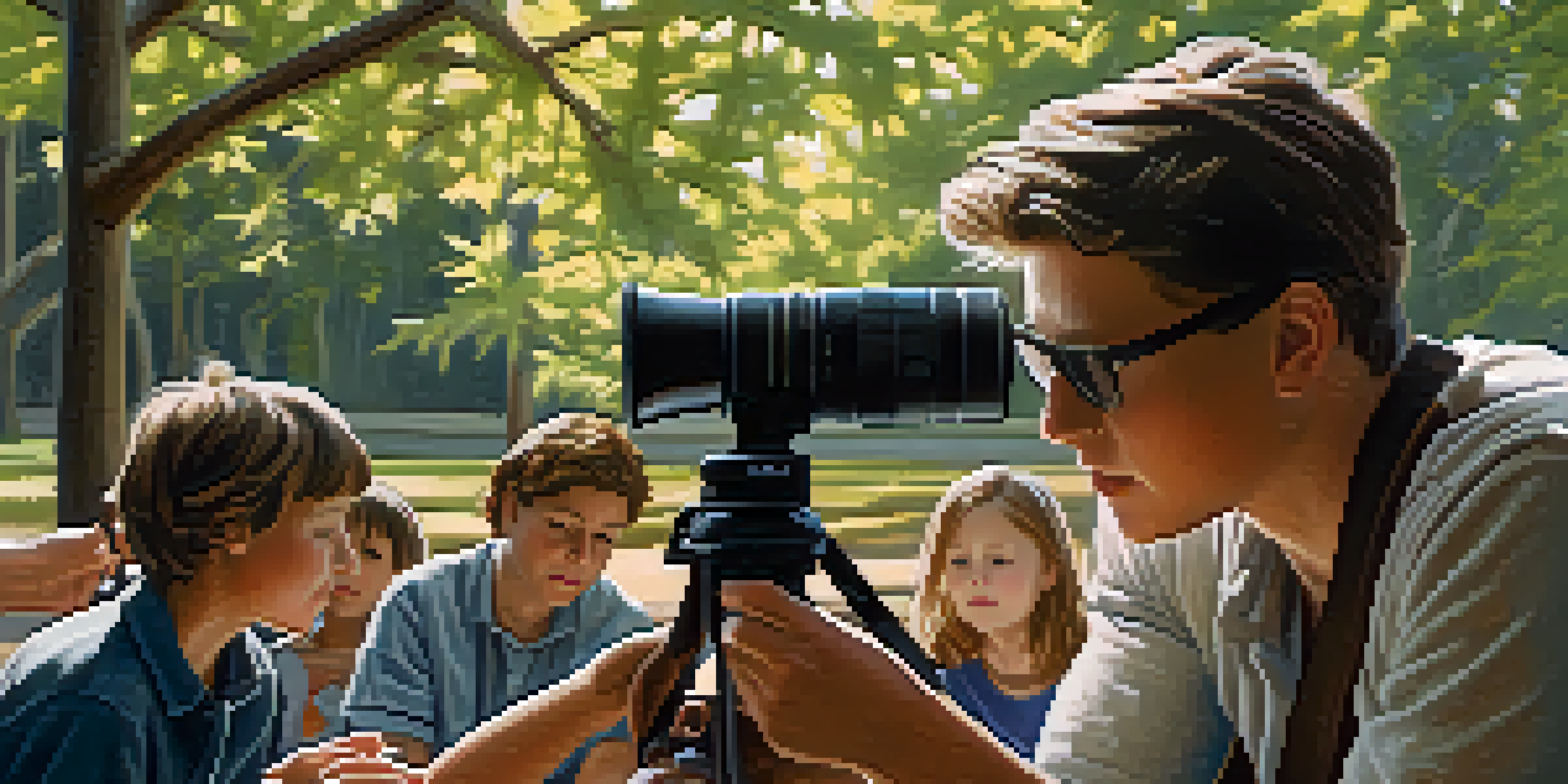The Art of Storytelling in Documentary Filmmaking

Understanding the Essence of Documentary Storytelling
Documentary storytelling is about weaving facts into narratives that resonate with audiences. Unlike fictional storytelling, it relies on real events, people, and truths, making authenticity crucial. The art lies in presenting these truths in a way that captivates viewers, encouraging them to engage with the subject matter on a deeper level.
Documentaries are the most powerful tool for social change we have, because they can reach people’s hearts and minds in a way that are often beyond the capabilities of traditional media.
At its core, a good documentary tells a compelling story that informs and emotionally connects with the audience. This involves careful selection of themes, characters, and events that not only convey information but also evoke empathy and understanding. For example, a documentary about climate change can highlight individual stories of impact to make the larger issue more relatable.
In essence, effective documentary storytelling transforms raw data into compelling narratives. Filmmakers must think like authors, considering dramatic arcs, character development, and emotional beats to create a journey that resonates with viewers. Ultimately, the goal is to leave the audience not just informed, but moved.
Choosing the Right Subject Matter for Engagement
The subject matter is the backbone of any documentary, and selecting the right one is crucial for engagement. Filmmakers should look for topics that not only interest them but also have the potential to resonate widely. This may involve exploring underrepresented stories or issues that provoke thought and discussion.

For instance, a documentary focusing on grassroots activists can shed light on significant social movements while giving a voice to those often overlooked. By choosing subjects that impact real lives, filmmakers create a sense of urgency and relevance that draws viewers in. The more relatable or pressing the issue, the more likely it is to capture the audience's attention.
Essence of Documentary Storytelling
Documentary storytelling weaves real events into compelling narratives that resonate emotionally with audiences.
Ultimately, the right subject matter invites viewers to reflect on their own experiences and beliefs. It can inspire action, change perceptions, or simply provide a new perspective, making the audience feel part of a larger conversation. This connection is vital for the documentary's impact and longevity.
Crafting Compelling Characters in Documentaries
Characters are the heart of any story, and in documentaries, they play an equally vital role. Compelling characters humanize the narrative, allowing audiences to connect emotionally with the subject matter. Whether they are the main protagonists or supporting figures, their stories should be authentic and relatable.
The best documentaries provoke more questions than they answer.
For example, consider a documentary about a struggling artist. By showcasing the artist's personal journey, challenges, and triumphs, viewers can empathize with their struggles and aspirations. This connection fosters a deeper understanding of the broader themes being explored, such as the value of creativity or the impacts of societal pressures.
Moreover, strong character development allows filmmakers to create dramatic tension and emotional arcs that keep the audience invested. As viewers witness characters evolving through challenges, they become more engaged in the narrative, making the documentary not just informative, but also a captivating experience.
Building a Narrative Arc in Documentary Storytelling
Every great story has a narrative arc, and documentaries are no exception. This arc typically includes an introduction, rising action, climax, and resolution, guiding viewers through the emotional landscape of the film. By structuring the documentary this way, filmmakers create a flow that keeps audiences engaged.
A well-crafted narrative arc allows filmmakers to build suspense and anticipation, leading the audience toward a satisfying conclusion. For instance, a documentary about a sports team overcoming adversity might start with their struggles, build up to a pivotal game, and culminate in their triumph or defeat. This structure not only keeps viewers on the edge of their seats but also enhances the emotional impact of the story.
Importance of Subject Matter
Choosing relevant and impactful subjects invites viewers to engage deeply and fosters a sense of connection.
In essence, a narrative arc transforms a collection of facts into a cohesive, engaging story. It helps audiences process the information presented and invest emotionally in the outcomes. Without this structure, a documentary risks becoming a series of disconnected scenes rather than a compelling narrative journey.
Using Visuals to Enhance the Storytelling Experience
In documentary filmmaking, visuals are more than just a backdrop; they are a powerful storytelling tool. Effective use of imagery can evoke emotions, highlight key moments, and reinforce the narrative. From breathtaking landscapes to intimate close-ups, visuals help convey the essence of the story being told.
For instance, a documentary about wildlife conservation might use stunning visuals of endangered species in their natural habitats to emphasize the urgency of the issue. These images not only captivate viewers but also create a visceral connection to the subject matter. When combined with the narrative, visuals can amplify the emotional and educational impact of the film.
Moreover, thoughtful cinematography can help establish tone and mood, influencing how audiences perceive the story. Whether it's through the use of light, color, or camera angles, visuals can enhance the storytelling experience, making it more immersive and memorable. This synergy between visuals and narrative is what sets powerful documentaries apart.
The Role of Sound and Music in Documentary Storytelling
Sound and music play a crucial role in shaping the atmosphere of a documentary. They can evoke emotions, set the pace, and enhance the storytelling experience. A well-chosen soundtrack can turn a simple scene into a powerful moment, guiding viewers’ feelings and reactions.
For example, a documentary covering a somber topic may use a slow, melancholic score to deepen the emotional weight of the narrative. Conversely, uplifting music can add a sense of hope and inspiration, leaving viewers feeling motivated and empowered. This emotional manipulation through sound helps to reinforce the documentary's message.
Visuals and Sound Enhance Impact
Effective use of visuals and sound enriches the storytelling experience, making documentaries more immersive and emotionally resonant.
Additionally, sound design, including the use of voiceovers and ambient sounds, can create a more immersive experience. By layering different audio elements, filmmakers can draw audiences into the world they are depicting, making the story feel more immediate and real. This integration of sound and music is essential for creating a captivating documentary.
Editing Techniques that Shape Documentary Narratives
Editing is where the magic happens in documentary filmmaking, allowing filmmakers to craft their narrative and control the pacing of the story. Through thoughtful editing, filmmakers can weave together different scenes, perspectives, and moments to create a cohesive narrative. This process is essential for ensuring that the documentary flows smoothly and maintains viewer engagement.
For instance, juxtaposing contrasting scenes can create powerful emotional impacts, such as showing the stark difference between a community thriving and one in despair. This technique can highlight key themes and provoke critical thinking among viewers. The choice of cuts, transitions, and pacing can all influence how the audience perceives the story.

Moreover, editing is also about knowing what to leave out. A skilled editor can identify the most compelling moments and remove extraneous content that detracts from the narrative. This refining process ensures that every frame serves a purpose, enhancing the overall impact of the documentary and keeping the audience invested from start to finish.